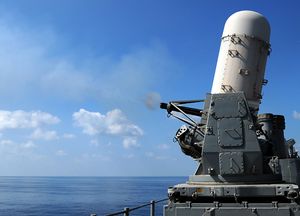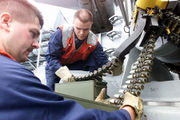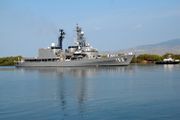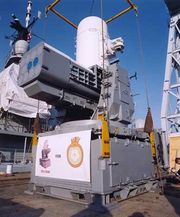Phalanx CIWS
| Phalanx CIWS | |
|---|---|
 Phalanx (Block 1a) live fire test, USS Monterey (CG-61) |
|
| Type | Close-in weapon system |
| Place of origin | United States |
| Service history | |
| In service | 1980-Present |
| Used by | See Operators |
| Production history | |
| Designer | General Dynamics (now Raytheon) |
| Manufacturer | General Dynamics (now Raytheon) |
| Produced | 1978[1] |
| Specifications | |
| Weight | 12,500 lb (5,700 kg), later models 13,600 lb (6,200 kg) [1] |
| Height | 4.7 m |
| Crew | Automated, with human oversight |
|
|
|
| Shell | Naval - Armor-piercing tungsten penetrator rounds with discarding sabots. Land - High-Explosive Incendiary Tracer, Self-Destruct. |
| Caliber | 20 mm |
| Barrels | 6 |
| Elevation | Block 0: -10 / +80 degrees Block 1: -20 / +80 degrees Block 1B: -25 / +85 degrees[2] |
| Traverse | -150 / +150 degrees[2] |
| Rate of fire | 3,000-4,500 rounds/minute [Selectable] (50-75 rounds/second). |
| Muzzle velocity | 1,100 m/s |
| Effective range | 3.6 km [2] |
| Maximum range | Classified [1][3] |
|
|
|
| Primary armament |
1 x 20 mm M61 Vulcan Gatling gun autocannon.[4] |
| Guidance system |
Ku-band radar and FLIR[5] |
The Phalanx CIWS is an anti-ship missile defense system. It is a close-in weapon system (CIWS) and was designed and manufactured by the General Dynamics Corporation, Pomona Division.[4], now Raytheon. Consisting of a radar-guided 20mm Gatling gun mounted on a swivelling base, the Phalanx is used by the United States Navy on every class of surface combat ship, by the United States Coast Guard aboard its Hamilton and Legend class cutters and the navies of 23 allied nations.
A land based variant known as C-RAM has recently been deployed in a short range missile defense role, to counter incoming rockets and artillery fire.[6]
Because of their distinctive barrel-shaped radome and their automated nature of operation, Phalanx CIWS units are sometimes nicknamed "R2-D2" after the famous droid from Star Wars,[7][8] and in the Royal Navy as Daleks, after the aliens from Doctor Who.
Contents |
History
Developed as the last line of automated weapons defense (terminal defense or point defense) against anti-ship missiles (AShMs), including high-g and maneuvering sea-skimmers, the first system was offered to the U.S. Navy for evaluation on USS King (DDG-41) in 1973. It was accepted and production started in 1978, the first ship fully fitted out was USS Coral Sea (CV-43) in 1980. The Navy began placing CIWS systems on non-combatant vessels in 1984.
Design
The basis of the system is the 20 mm M61 Vulcan Gatling gun autocannon, used since the 1960s by the United States military in nearly all fighter aircraft (and one land mounting, the M163 VADS), linked to a Ku-band radar system for acquiring and tracking targets. This proven system was combined with a purpose-made mounting, capable of fast elevation and traverse speeds, to track incoming targets. An entirely self-contained unit, the mounting houses the gun, an automated fire control system and all other major components, enabling it to automatically search for, detect, track, engage and confirm kills using its computer-controlled radar system. Due to this self-contained nature, Phalanx is ideal for support ships which lack integrated targeting systems and generally have limited sensors. The entire unit has a mass between 5,500 and 6,100 kg (12,400 to 13,500 lb).
Upgrades
Due to the continuing evolution of both threats and computer technology, the Phalanx system has, like most military systems, been developed through a number of different configurations. The basic (original) style is the Block 0, equipped with first generation solid state electronics and with marginal capability against surface targets. The Block 1 (1988) upgrade offered various improvements in radar, ammunition, rate of fire, increasing engagement elevation to +70 degrees, and computing. These improvements were intended to increase the system's capability against emerging Soviet (?) supersonic anti-ship missiles. Block 1A introduced a new computer system to counter more maneuverable targets. The Block 1B PSuM (Phalanx Surface Mode, 1999) adds a forward looking infrared (FLIR) sensor to allow the weapon to be used against surface targets.[9] This addition was developed to provide ship defense against small vessel threats and other "floaters" in littoral waters and to improve the weapon's performance against slower low-flying aircraft. The FLIR's capability is also of use against low-observability missiles and can be linked with the RIM-116 Rolling Airframe Missile (RAM) system to increase RAM engagement range and accuracy. The Block 1B also allows for an operator to visually identify and target threats.[9]
The U.S. is in the process of upgrading all their Phalanx systems to the Block 1B configuration. The Block 1B is also used by other navies such as Canada, Portugal, Japan, Egypt, Bahrain and the UK.[10]
In May 2009 the US Navy awarded a $260 million contract to Raytheon Missile Systems to perform upgrades and other work on the Phalanx. The work is to be completed by September 2012.[11]
Operation
The CIWS is designed to be the last line of defense against anti-ship missiles. Due to its design criteria its effective range is very short relative to the range of modern ASMs, from 1 to 5 nautical miles (9 km). The gun mount moves at a very high speed and with great precision. The system takes minimal inputs from the ship, making it capable of functioning despite potential damage to the ship. The only inputs required for operation are 440 V AC at 60 Hz and water for electronics cooling. For full operation including some non-essential functions, it also has inputs for true compass ship's heading and 115 V AC for the PASS and tape drive subsystems.

Radar subsystems
The CIWS has two antennas that work together to engage targets. The first antenna, for searching, is located inside the radome on the weapon control group (top of the white-painted portion). The search subsystem provides bearing, range, velocity, heading, and altitude information of potential targets to the CIWS computer. This information is analyzed to determine whether the detected object should be engaged by the CIWS system. Once the computer identifies a valid target (see details below), the mount moves to face the target and then hands the target over to the track antenna. The track antenna is extremely precise, but views a much smaller area. The tracking subsystem observes the target until the computer determines that the probability of a successful hit is maximized and then, depending on the operator conditions, the system will either fire automatically or will recommend fire to the operator. While firing, the system tracks outgoing rounds and 'walks' them onto the target.
Gun and ammunition handling system

The Block 0 CIWS mounts (hydraulic driven) fired at a rate of 3,000 rounds per minute and they could only hold 989 rounds in the magazine drum.[4] The Block 1 CIWS mounts (hydraulic) also fired at 3,000 rounds per minute with an extended magazine drum holding 1,550 rounds. The Block 1A and newer (pneumatic driven) CIWS mounts fire at a rate of 4,500 rounds per minute and also had the larger 1,550 round magazine. The velocity of the rounds once fired is approximately 3,600 feet per second (1,100 m/s). The rounds are armor-piercing tungsten penetrator rounds or depleted uranium with discarding sabots. The kinetic projectiles are designed to pierce and explode an incoming missile's warhead. The ammunition handling system has two conveyor belt systems. The first takes the rounds out of the magazine drum and to the gun; the second takes either the empty shells or non-fired rounds and routes them back to the opposite end of the drum.
CIWS contact target identification
The CIWS does not recognize identification friend or foe, also known as IFF. The CIWS has only the data it collects in real time from the radars to decide if the target is a threat and to engage it. A contact has to meet multiple criteria for it to be considered a target. Some of the criteria are listed below.

- Is the range of the target increasing or decreasing in relation to the ship? The CIWS search radar will see contacts that are out-bound and discard them. The CIWS will only engage a target if it is approaching the ship.
- Is the contact capable of maneuvering to hit the ship? If a contact is not heading directly at the ship, the CIWS looks at its heading in relation to the ship and its velocity. It then decides if the contact can still perform a maneuver to hit the ship.
- Is the contact traveling between the minimum and maximum velocities? The CIWS has the ability to engage targets that travel in a wide range of speeds, however it is not an infinitely wide range. The system has a target maximum velocity limit. If a target exceeds this velocity, the CIWS will not engage it. It also has a minimum target velocity limit. Any contact below that velocity will not be engaged by the CIWS. The operator also has the option to adjust the minimum and maximum limits within the limits of the system.
There are many other subsystems which together ensure proper operation, such as environmental control, transmitter, mount movement control, power control and distribution and so on. It takes 6 to 8 months to train a technician to maintain, operate, and repair the CIWS.
Phalanx incidents in combat

On February 25, 1991, during the first Gulf War, the Phalanx-equipped USS Jarrett (FFG-33) was a few miles from the USS Missouri (BB-63) and the destroyer HMS Gloucester (D96). The ships were attacked by an Iraqi Silkworm missile (often referred to as the Seersucker), at which Missouri fired its SRBOC chaff. The Phalanx system on Jarrett, operating in the automatic target-acquisition mode, fixed upon Missouri's chaff, releasing a burst of rounds. From this burst, four rounds hit Missouri which was two to three miles (about 5 km) from Jarrett at the time. There were no injuries.[12] A Sea Dart missile was then launched from the Gloucester, which destroyed the Iraqi missile, achieving the first successful engagement of a missile by a missile during combat at sea.
Accidental downing of US aircraft
On June 4, 1996, a Japanese Phalanx accidentally shot down a US A-6 Intruder that was towing a radar target during gunnery exercises. A Phalanx aboard the Asagiri class destroyer Yūgiri locked onto the Intruder instead of the target. Both pilots ejected safely.[13] A post-accident investigation concluded that the Yūgiri's gunnery officer gave the order to fire before the A-6 was out of the CIWS engagement envelope.[14][15]
21st century
Centurion C-RAM
Seeking a solution to constant rocket and mortar attacks on bases in Iraq, the United States Army requested a quick-to-field anti-projectile system in May 2004, as part of its Counter-Rocket, Artillery, Mortar initiative.[16] The end result of this program was 'Centurion'. For all intents and purposes a terrestrial version of the Navy's CIWS, the Centurion was rapidly developed,[17] with a proof of concept test in November that same year. It began deployment to Iraq in 2005,[16][18] where it was set up to protect forward operating bases and other high-value sites in and around the capital, Baghdad.[19] Israel has purchased a single system for testing purposes, and is reported[20] to be considering buying the system to counter rocket attacks and defend point military installations, investments made in their own indigenous air defence system, Iron Dome, has provided competition to Centurion.[20][21]
Each system uses consisted of a modified Phalanx 1B CIWS, powered by an attached generator and mounted on a trailer for mobility. Armed with a 20 mm M61A1 Gatling gun the unit is capable of firing 1,500 or 2,000 M-246 or M-940 rounds per minute.[6][22] In 2008 there were more than twenty CIWS systems protecting bases in the U.S. Central Command area of operations. A Raytheon spokesman told Navy Times that 105 attacks were defeated by the systems, most of those involved mortars. Based on the success of Centurion, 23 additional systems were ordered in September 2008.[23]
Like the naval (1B) version, Centurion uses Ku-band radar and FLIR[24] to detect and track incoming projectiles, and is also capable of engaging surface targets, with the system able to reach a -25 degree elevation.[24] The Centurion is reportedly capable of defending a 1.2 km square area.[25] One major difference between the land and sea based variants is the choice of ammunition. Whereas naval Phalanx systems fire tungsten armor-piercing rounds, the C-RAM uses the M246 or M940 HEIT-SD (High-Explosive Incendiary Tracer, Self-Destruct) ammunition, originally developed for the M163 Vulcan Air Defense System.[17][26] These rounds explode on impact with the target, or upon tracer burnout, thereby greatly reducing the risk of collateral damage, should any rounds fail to hit their target.[17][26]
SeaRam

Utilising the armament of the RIM-116 Rolling Airframe Missile, and based on the mounting and targeting systems of the Phalanx, SeaRAM was developed in response to concerns about the performance of gun-based systems against modern, super-sonic sea-skimming anti-ship missiles. Designed as a companion self-defense system to Phalanx,[27] the SeaRAM is equipped with an 11 cell RAM launcher, and provides defense at a longer range. Due to the common mounting, SeaRAM inherits the relatively easy installation characteristics of its gun-based sibling, with Raytheon stating that "[SeaRAM] fits the exact shipboard installation footprint of the Phalanx, uses the same power and requires minimal shipboard modification".[27] Currently in the trial stages, SeaRAM is fitted to the Independence Class Littoral Combat Ship.[27]
Operators
 Australia[28]
Australia[28] Bahrain[28]
Bahrain[28] Canada[28]
Canada[28] Egypt[28]
Egypt[28] Greece[29]
Greece[29] Israel[28]
Israel[28] Japan[28]
Japan[28] India[30]
India[30] Malaysia[28]
Malaysia[28] Mexico[28]
Mexico[28] New Zealand[28]
New Zealand[28] Poland[28]
Poland[28] Pakistan[31]
Pakistan[31] Portugal[31]
Portugal[31] Saudi Arabia[28]
Saudi Arabia[28] Singapore[28]
Singapore[28] Thailand[32]
Thailand[32] Taiwan[28]
Taiwan[28] United States[31]
United States[31] United Kingdom[31]
United Kingdom[31]
Specifications
(For Block 1A/B)
- Gun: 20 mm M61 Vulcan Gatling gun autocannon.[4]
- Height: 4.7 m.
- Weight: 12,500 lb (5,700 kg), later models 13,600 lb (6,200 kg) [1]
- Elevation +82 to −25 degrees.
- Muzzle velocity: 1,100 m/s.
- Rate of fire: 2,000 rounds/minute.
- Maximum burst size: 1000 rounds.
- Ammunition: 1,550 rounds.
- Radar: Ku band.
- 100% Kill distance: 8 miles (10 km)
- Cost: $1.5 Million (gun system only - no radar)
Similar systems
- AK-630, Russian CIWS
- Kashtan, Russian CIWS
- Goalkeeper CIWS, Dutch CIWS
- Meroka CIWS, Spanish navy
- SeaRAM, U.S. missile-based CIWS
- Type 730 CIWS, Chinese CIWS
Notes
- ↑ John Pike (2005-04-27). "MK 15 Phalanx Close-In Weapons System (CIWS)". Globalsecurity.org. http://www.globalsecurity.org/military/systems/ship/systems/mk-15-specs.htm. Retrieved 2010-04-13.
- ↑ 4.0 4.1 4.2 4.3 Thomas, Vincent C. The Almanac of Seapower 1987 Navy League of the United States (1987) ISBN 0-9610724-8-2 p.191
- ↑ http://www.raytheon.com/capabilities/rtnwcm/groups/rms/documents/content/rtn_rms_ps_phalanx_ciws_datash.pdf
- ↑ 6.0 6.1 "Murdoc online March 20, 2006 CIWS now does surface targets, too". Murdoconline.net. http://www.murdoconline.net/archives/003558.html. Retrieved 2010-04-13.
- ↑ "Spacewar.com". Spacewar.com. http://www.spacewar.com/reports/Phalanx_Has_A_Future_999.html. Retrieved 2010-04-13.
- ↑ "TELUS, news, headlines, stories, breaking, canada, canadian, national". Home.mytelus.com. http://home.mytelus.com/telusen/portal/NewsChannel.aspx?CatID=National&ArticleID=news/capfeed/national/n111837A.xml. Retrieved 2010-04-13.
- ↑ 9.0 9.1 "Raytheon Company: Phalanx". Raytheon.com. http://www.raytheon.com/capabilities/products/phalanx/. Retrieved 2010-04-13.
- ↑ "Raytheon Awarded Phalanx 1B Upgrade Order for Royal Navy". Prnewswire.com. http://www.prnewswire.com/cgi-bin/micro_stories.pl?ACCT=149999&TICK=RTN&STORY=/www/story/04-19-2006/0004342799&EDATE=Apr+19,+2006. Retrieved 2010-04-13.
- ↑ Arizona Daily Star, May 16, 2009. "Navy Awards $260 Million In Additional Work On Ship Weapons System To Raytheon"
- ↑ "Tab-H Friendly-fire Incidents". Gulflink.osd.mil. http://www.gulflink.osd.mil/du_ii/du_ii_tabh.htm. Retrieved 2010-04-13.
- ↑ Cable News Network. Japan apologizes for gunning down U.S. plane. June 4, 1996.
- ↑ The Virginian-Pilot. Human Error Cited In Downing Of Navy Plane By Japanese. October 24, 1996.
- ↑ Transcript of the DoD investigation of the incident
- ↑ 16.0 16.1 "Army C-RAM Intercepts 100th Mortar Bomb in Iraq". Defense-update.com. 2007-06-07. http://defense-update.com/newscast/0508/news/news2105_c_ram.htm. Retrieved 2010-04-13.
- ↑ "First C-RAM joint intercept battery organizes for combat. - Free Online Library". Thefreelibrary.com. http://www.thefreelibrary.com/First+C-RAM+joint+intercept+battery+organizes+for+combat.-a0193035939. Retrieved 2010-04-13.
- ↑ http://www.timripley.co.uk/articles/jdw_uk_deploys_c_ram.pdf
- ↑ 20.0 20.1 "BMD Focus: Barak dithered on Phalanx". Spacewar.com. http://www.spacewar.com/reports/BMD_Focus_Barak_dithered_on_Phalanx_999.html. Retrieved 2010-04-13.
- ↑ "Anti-Qassam Missile Defense Part One". Spacewar.com. http://www.spacewar.com/reports/Anti-Qassam_Missile_Defense_Part_One_999.html. Retrieved 2010-04-13.
- ↑ "Israel may buy rapid-fire cannon" Jerusalem Post Dec 20, 2007
- ↑ Analyst: DDGs without CIWS vulnerable. Navy Times. September 16, 2008
- ↑ 24.0 24.1 http://www.raytheon.com/capabilities/rtnwcm/groups/rms/documents/content/rtn_rms_ps_phalanx_datasheet.pdf
- ↑ 23-Apr-2009 13:20 EDT (2009-04-23). "A Laser Phalanx?". Defenseindustrydaily.com. http://www.defenseindustrydaily.com/a-laser-phalanx-03783/. Retrieved 2010-04-13.
- ↑ 26.0 26.1 "Counter-RAM Systems Target Rockets". Aviation Week. 2009-08-27. http://www.aviationweek.com/aw/generic/story_channel.jsp?channel=defense&id=news/RAM082709.xml&headline=Counter-RAM%20Systems%20Target%20Rockets. Retrieved 2010-04-13.
- ↑ 27.0 27.1 27.2 Raytheon. SeaRAM datasheet. (PDF)
- ↑ 28.00 28.01 28.02 28.03 28.04 28.05 28.06 28.07 28.08 28.09 28.10 28.11 28.12 "Mk 15 Phalanx Block 0 / CIWS, Close-In Weapon System". Deagel.com. 2010-03-07. http://www.deagel.com/Ship-Air-Defense-Systems/Mk-15-Phalanx-Block-0_a001641001.aspx. Retrieved 2010-04-13.
- ↑ "World Navies Today: Greece". Hazegray.org. 2002-03-24. http://www.hazegray.org/worldnav/europe/greece.htm. Retrieved 2010-04-13.
- ↑ "Navy to get weapon of light". Hindustan Times. 2008-07-21. http://www.hindustantimes.com/News-Feed/india/Indian-Navy-to-get-weapon-of-light/Article1-325364.aspx. Retrieved 2010-04-13.
- ↑ 31.0 31.1 31.2 31.3 "Mk 15 Phalanx Block 1B / CIWS, Close-In Weapon System". Deagel.com. http://www.deagel.com/Ship-Air-Defense-Systems/Mk-15-Phalanx-Block-1B_a001641003.aspx. Retrieved 2010-04-13.
- ↑ "World Navies Today: Thailand". Hazegray.org. 2002-03-25. http://www.hazegray.org/worldnav/asiapac/thailand.htm. Retrieved 2010-04-13.
External links
- Official United States Navy Warfighters Encyclopedia CIWS page
- GlobalSecurity.org fact file
- Raytheon Company Phalanx CIWS product page
- Ground based Phalanx in action (video)